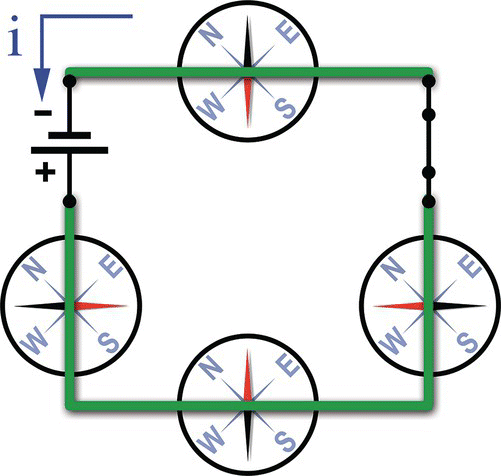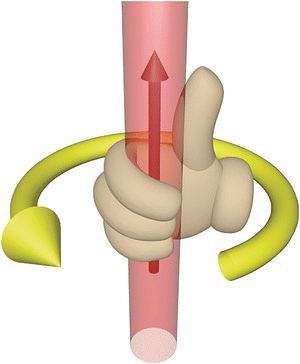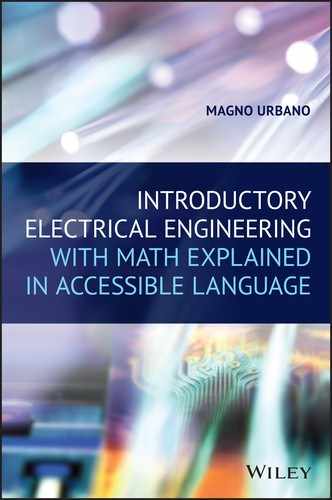9
Electromagnetism: And the World Revolution
9.1 Introduction
In this chapter, we will examine electromagnetism and the effects of electromagnetic induction, one of the greatest discoveries of physics of all times that changed the world forever.
9.2 The Theory
The effects of magnets over certain materials and their interference in compasses were well known for centuries.
The discovery that magnets have poles and that identical poles repel and opposite poles attract each other came later.
Electricity and magnetism were seen as separate entities, with no relation to each other and no practical usage in daily life.
9.3 Hans Christian Ørsted
In 1890, Hans Christian Ørsted, a Danish physicist, discovered that an electric current was able to produce a magnetic field.
The proof was simple: a battery connected to a wire suspended over compasses and a switch initially open.
Without current, the compasses all point to the Earth’s magnetic north, as expected, as illustrated in Figure 9.1.
As soon as the switch is closed, current flows across the wire and gives rise to a magnetic field. This magnetic field interferes with the compasses that move to follow the field, as illustrated in Figure 9.2.
Placing the compasses over the wire would make their needles point to the opposite direction. We will know why in the following paragraphs.

Figure 9.1 Ørsted experiment (open circuit).

Figure 9.2 Ørsted experiment (switch closed).

Figure 9.3 Ørsted experiment (battery is inverted).
Keeping the compasses below the wire and inverting the battery make current flow in the opposite direction, giving rise to a magnetic field with an opposite direction. This will force the compasses to rotate 180° to point to the new magnetic field direction, as shown in Figure 9.3.
Once more, placing the compasses over the wire will make their needles point to the opposite direction.
Magnetic fields have a specific orientation that depends on the current flow direction.
To find the magnetic field orientation, we can use the right‐hand rule.
9.4 The Right‐Hand Rule
Imagine a right hand grabbing a wire. The thumb points to the current flow direction as illustrated by the black arrow pointing up in Figure 9.4.

Figure 9.4 Right‐hand rule.
For a right hand grabbing a wire like this, the magnetic field circulates the wire and points in the direction of the other fingers, as illustrated in Figure 9.4.
Magnetic fields are normally designated in technical literature by the uppercase letter B and have the circular form, shown in Figure 9.5, for a current flowing in the direction of I.

Figure 9.5 Magnetic field created by a current flow.
9.5 Faraday First Experiment
After Ørsted discovery, Michael Faraday1 suggested that if a current could generate a magnetic field, perhaps a magnetic field could produce current.
To prove this hypothesis, Faraday wounded a few turns of wire forming two coils and placed one inside the other, as shown in Figure 9.6.
The first coil was connected to a circuit with a battery and a switch initially open and the second coil was connected to the outside coil and a device that could measure current flow,2 as seen in Figure 9.7.

Figure 9.6 A coil inside another one.

Figure 9.7 Faraday experiment: primary and secondary circuit.
After turning the switch on or off, Faraday noticed a brief current on the secondary circuit. The secondary current was only present the moment the switch was open or closed.
Faraday noticed that current would only appear on the secondary circuit when current was varying in the primary. Then, he concluded that a variable magnetic field could create a current on the secondary circuit.
9.6 Faraday Second Experiment
If a variable current produces magnetic field, then a variable magnetic field should produce current.
To confirm this hypothesis, Faraday imagined the following experiment: a fixed coil connected to a circuit and a magnet. The magnet was adjusted to move in and out of the coil, as shown in Figure 9.8.

Figure 9.8 An inductor and a magnet.
The hypothesis confirmed to be true. Current is created in the coil as soon as the magnet moves in or out. The faster the movement, the bigger the current. The bigger the number of wounds of wire or the strongest the magnet, the bigger the current.
Faraday also noticed that moving the magnet in the coil would produce current in one direction and moving the magnet off the coil would produce current in the other direction, producing fields in opposite directions.
Another thing later discovered is that a coil moving in a fixed magnetic field could also produce current.
9.7 Conclusion
The principles of electromagnetism discovered by Faraday are, possibly, one of the most important discoveries of all times.
These discoveries lead to future creations by Siemens, like the electric elevator, electric generator, and Tesla’s alternating current generator, responsible for the first transmissions of electric power over long distances and the development of a new society.
The base for the world revolution was created.
Without electromagnetism, we would not have motors, airplanes, television, Internet, computers, or anything a modern society offers, and we would still be living with carriages and horses.
